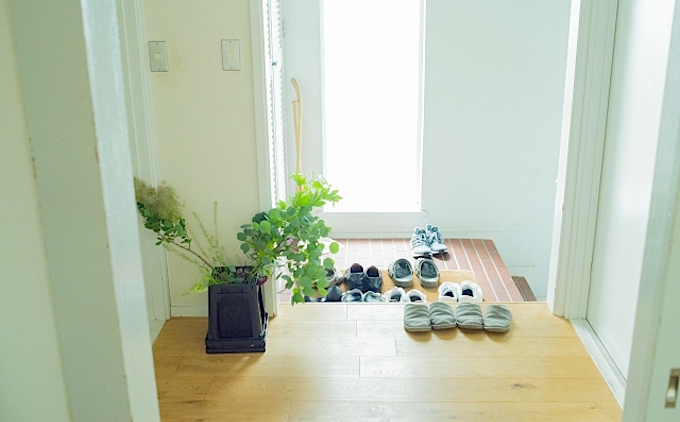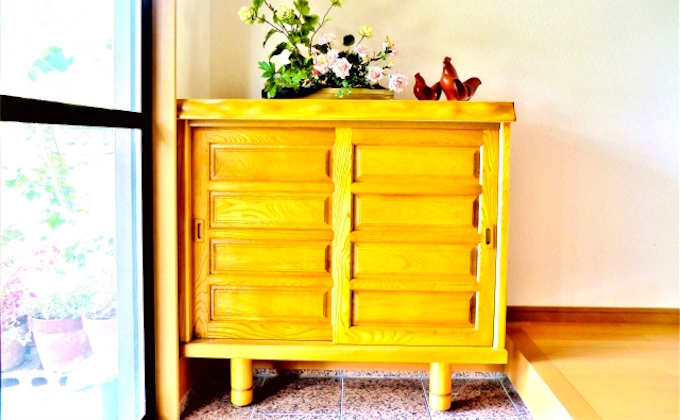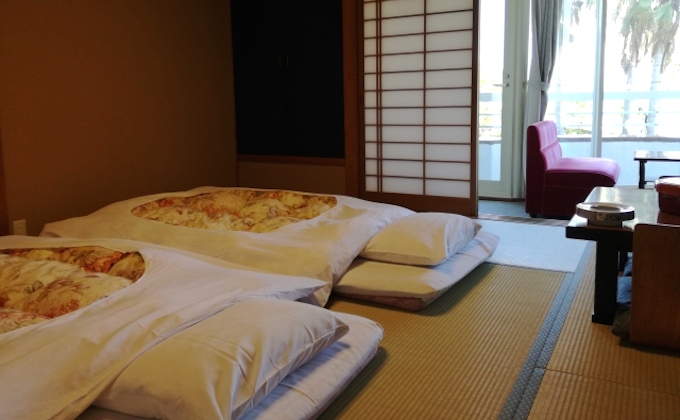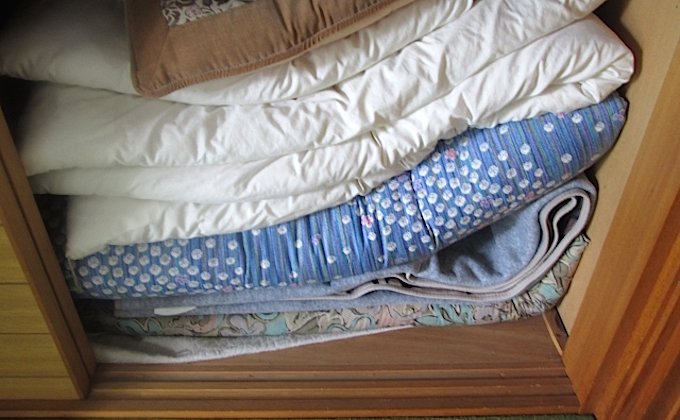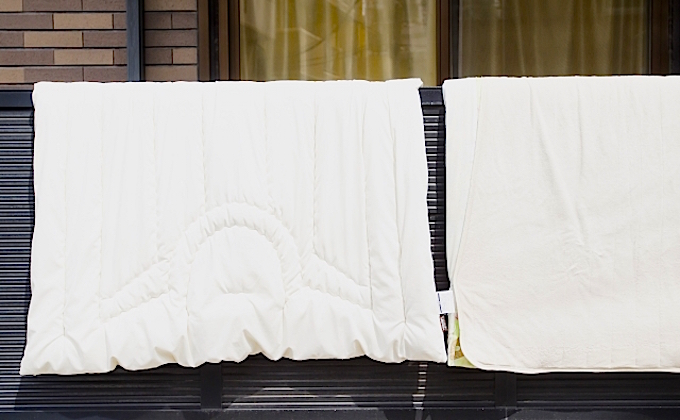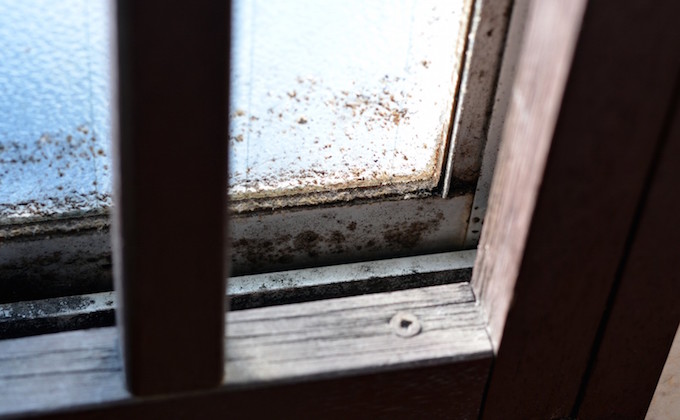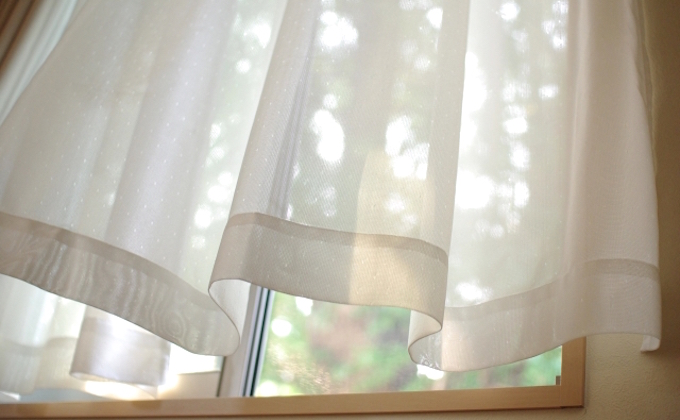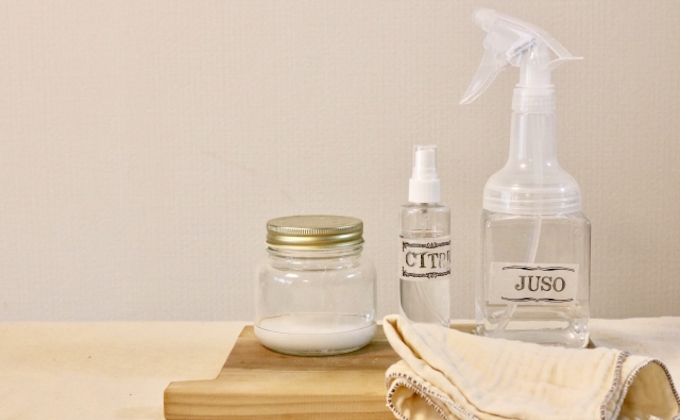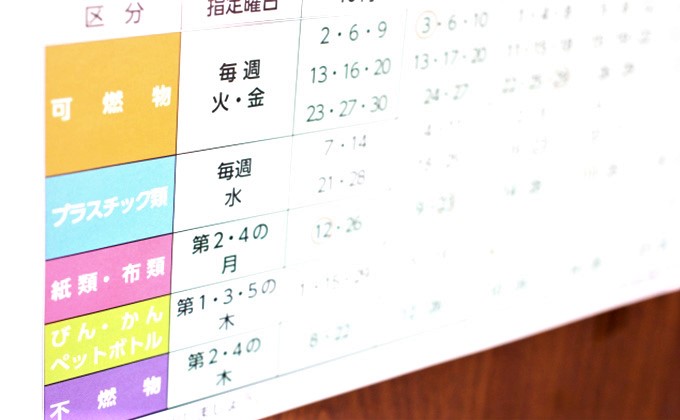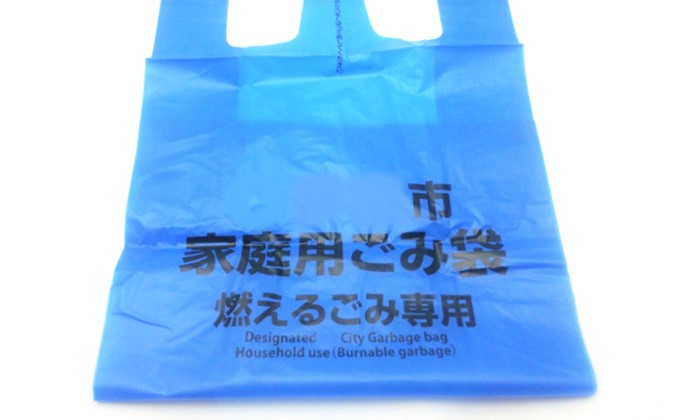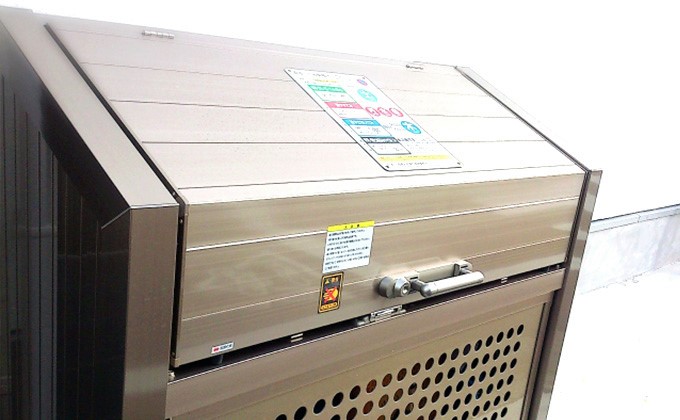TRG Info and Advice
Some Japanese Housekeeping Observations (from someone who grew up in a totally different world)
Removing your Shoes
Japanese homes are designed for the easy removal of outdoor shoes. In the genkan, or entryway, there is a step or elevated area that leads into the home. The genkan is considered a public space, meaning anyone can enter, so keeping it neat (floor swept, shoes lined up, etc.) will prevent feelings of embarrassment when a package is delivered or a friend drops by unannounced.
Outside shoes are taken off here and stored in the getabako (a closet or special shelves for shoes). If you are a visitor, it is polite to turn your shoes around after stepping up and into the house (if you do not do this, your host will do it for you, putting his or her hands into your potentially stinky shoes, so…). If you need to sit down to remove your shoes, sitting on the elevated step is perfectly acceptable, or there may be a stool or bench for that purpose. Your host will most likely have a pair of slippers waiting, or readily available, for you. (If it makes you feel uncomfortable to wear slippers that have, mostly likely, been worn by others, make sure you always have your own, portable pair in your bag, or at least have a pair of socks with you, so that you won’t be wearing them barefoot!)
These slippers can be worn in the hallway and any other rooms with flooring. They should be removed, however, upon entering a room with tatami mats. When going to the bathroom, also, the house slippers should be exchanged for toilet slippers (usually lined up just outside). Try to remember to put the house slippers back on after using the facilities, and don’t walk around wearing the toilet slippers like this writer did…
As the host, it is your job to make sure your guests’ shoes are lined up neatly, ready to be stepped into when it is time to leave. Some people say this habit of lining up shoes is in preparation for an emergency, like a house fire or an earthquake, where quick evacuation becomes necessary. It is also polite to provide a clean pair of slippers for every guest. Keeping a basket or rack of seasonally appropriate slippers near the door will save you time and trouble. You should also have a pair of slippers exclusively for the toilet. If you do not, your Japanese guests may feel uncomfortable using the facilities.
There are many theories as to why this Japanese tradition of removing one’s shoes persists, despite the westernization of many homes. In one survey, sponsored by the Japan Forum, the top two reasons were overwhelmingly: for cleanliness and for relaxation. In Japanese homes, people are more likely to sit and sleep on cushions, or directly on the floor, so it makes sense to keep it as clean as possible by not tracking in outdoor dirt and germs. Additionally, in a society that makes many social and professional demands on people, separating that outside world from home by removing one’s shoes seems a fundamental part of being able to relax.
Another reason cited by the Japan Forum survey was that original Japanese shoes like zori (flat, thong-like sandals made from a variety of materials, including rice straw and/or cloth) and geta (usually elevated, thong-like sandals, most often made of wood, like a combined clog and flip-flop) allowed air to flow. Western shoes are not suitable to Japan’s humid climate, and wearing them all day long does not promote healthy feet. Removing them upon returning home, or entering someone’s home, gives your feet a chance to breath.
Caring for Futons
Japanese futons are much thinner than the Western couch/bed ones that were popular in the 80’s and 90’s. You start with a thin, single-sized futon, called a shikibuton, which lies directly on the floor. Rooms with tatami are the best place to sleep on a Japanese futon. If you do not have a room with tatami, you might want to purchase a wood frame for your futon, called a sunoko. Another option is to buy separate, thin pieces of tatami to put under your futon. Cover the shikibuton with a sheet, or a special cover case that zips. Some people add a thin pad that is attached at the corners with elastic straps. Next comes a combination of coverings, depending on the season.
In summer, due to the intense heat and humidity, people use what is called a towelket, which is exactly what the name implies: part towel, part blanket. The towelket is absorbent, yet provides protection from sudden night breezes and temperature drops. Even if you are sweating, Japanese people put great importance on covering the belly/midsection of your body. Kids’ pajamas even have snaps to keep them closed over their stomachs, or they wear a special “stomach warmer” type of thing called a haramaki. Supposedly, this helps with both digestion and circulation. It’s also used to support the “bump” if you are pregnant.
In the other seasons, spring, fall and winter, people use a combination of coverings: a towelket or regular blankets of various materials, plus a kakebuton, what Westerners might call a comforter or duvet. There are all types of kakebuton, from heavy, colorfully traditional, 100% cotton batting-filled ones to light, down-filled, and synthetic, machine-washable ones. They come in all sizes, too, so don’t be afraid to ask for an extra-long one if you are a tall drink of water.
Usually, the room designated as the shinshitsu (bedroom) has tatami flooring, and a storage closet with sliding doors and shelves for putting away your bed EVERYDAY! Japanese futons are not meant to be left out, especially during the rainy season and humid summer months. You will be growing some serious, petri-dish-worthy molds if you do not put away your futon on a daily basis. It is also a good idea, on sunny days, to throw your shikibuton out over your balcony railing, onto a lower roof, or even just over the window sill to give it some sun and air. The other bedding could use some sun on occasion, too, but if you only have time or space for one, choose the shikibuton! Sunning your bedding on a regular basis will not only keep it smelling fresh, it will help get rid of some of those unwanted microscopic organisms.
Fighting Mold
In the bathroom, in the closets, climbing up your favorite leather skirt, turning your best suede pumps a fuzzy green, mold is your worst enemy from the beginning of the rainy season until the end of summer! There are a million cleaning products in Japanese stores, but if you want to keep things simple, and more environmentally responsible, here are a few ideas and options.
Open the windows! Let in a breeze (if there is one!) and the sun (if it is available), too! Bathroom, kitchen and toilet windows should be left open as much as possible, closet doors, too! If wind and sun are absent, turn on the fans to keep the air moving.
Wipe down surfaces regularly! After a shower or bath, spray the room with cold water to reduce the temperature (mold loves heat!), then wipe it down with a towel or chamois cloth (mold loves water!). Baking powder and a dash of tea tree oil shaken in an old parmesan cheese container makes a fantastic eco-friendly scrub for the bath or shower, and every washbasin from the toilet to the kitchen. Vinegar and water, combined in a spray bottle with 10-15 drops of your favorite essential oil, makes a great all-purpose cleanser for floors, doorframes, and countertops.
Use a dehumidifier, either electric or portable, or the “dry” setting on your air conditioner. These options are not very eco-friendly, but on those especially wet and warm days, a dehumidifier can suck up extra moisture and prevent the growth of unsightly molds. Portable (non-electric) dehumidifiers can be placed in closets and other confined areas year-round, but don’t forget to change them every now and then.
For food products, keeping staples like rice and flour in the fridge from June to September is the safest bet. Fruits and vegetables should be consumed quickly, or canned or frozen. If your kitchen has a small root cellar, you might be able to keep onions, pumpkins and potatoes there, but try to keep them spread out from each other.
Bottom line is, it’s especially important to stay on top of your house-keeping game during the hot and humid summer months!
Garbage and Recycling
Garbage and recycling schedules are different depending on where you live or are staying in Japan. Big cities may have stricter regulations, like what type of plastics can be recycled, and what to do about food waste. The sanitation department usually provides both information on how to separate your trash, and a yearly calendar of what gets picked up, and when. Try to get your hands on a schedule, ask a neighbor, or visit the nearest garbage “cage” or pick-up spot, where a schedule is usually posted. The schedule may look something like this: combustibles (including organic waste in some places) on Mondays and Fridays, plastics on Tuesdays, PET bottles on the 1st and 3rd Wednesday of the month (no labels or caps, though!)*, cans and bottles on the 2nd and 4th Wednesday of the month, non-combustible garbage on the 2nd and 4th Thursday of the month, and big garbage (TVs, furniture, machinery) 3-4 times a year. Paper pick-up is also provided in some areas, or you may have to take your recyclable paper products directly to a paper-recycling plant.
Some cities provide financial assistance for those households that want to purchase a composting machine. This takes your organic waste and breaks it down into precious fertilizer that you can use for your houseplants or garden, or give to any farmers in the neighborhood! Another option is, if you have a green thumb and a bit of land, to try your hand at a compost pile. Unlike most neighborhoods in the US, a high percentage of homes in rural Japanese villages have vegetable and flower gardens, with a humus pile nearby for easy and eco-friendly composting.
Special bags are required for some types of garbage, and need to be purchased (you can usually find them at the grocery store or a home-center). Some places ask that you write your name and apartment number on your garbage bags, so that you can be identified and informed of any mistakes in your disposal methods. Designated community members may be patrolling the garbage pick-up site on a regular basis to make sure people are complying with regulations. Failure to observe these rules could result in a fine…so, be careful.
Why does the garbage go in a cage or under a big net? To prevent wild animals, stray dogs and cats, and birds from getting into it and making a big mess, of course! This is why it is generally frowned upon to put your garbage out the night before, especially if it has food waste in it.
Warning: If you are living in rural Japan and see an elderly person heading toward a blackened patch of earth, pushing a cart laden with Styrofoam boxes and other garbage, run home, bring in your laundry and futons, and close your windows and doors! Though, officially, strict rules regarding garbage disposal are in place, many members of the older generation have yet to adjust to the idea. In the past, people took care of their own garbage by burning it in the yard, or in an old oil barrel, and for some, that habit continues. Dioxin, furans and other dangerous chemicals released when plastics are burned can cause numerous health complications. Putting in a call to the local government office may bring an official to reprimand the culprit, but your neighbors will probably quickly guess who made the call! Speaking honestly and directly to the offender about the link between burning plastics in the yard and your resulting headaches or children’s aggravated asthma may have more positive results
*PET bottle caps are often collected separately at convenience stores, or local schools. They are then sold to recycling companies as a fund-raiser for polio vaccinations in developing countries.







